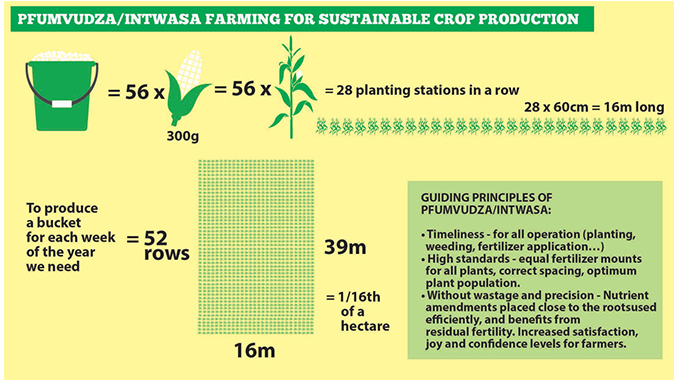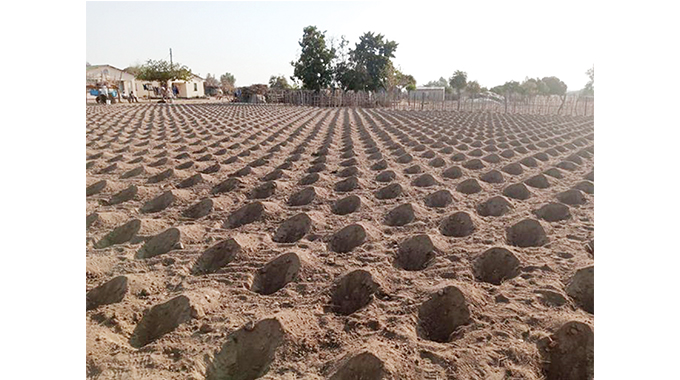
Prosper Ndlovu, Business Editor
DUE to the growing incidence of climate change-induced droughts, agricultural productivity in Zimbabwe and the Southern African region has been going down in the past few years. The trend is increasingly threatening national food security with negative impact on balance of payments while agro-based industrial activity is also adversely affected.
As rain fed agriculture becomes increasingly unreliable, Government and development partners have this year introduced a new farming model code named “Intwasa-Gebha udle/Pfumvudza”, which is being piloted across the country. As the 2020-2021 cropping season draws nearer Government, through the Department of Agricultural Technical and Extension Services (Agritex), has intensified farmer training programmes in districts while input distribution interventions are also being rolled out.
More than 300 000 farmers across the country had been trained on the model by end of July, with most of them already carrying out land preparations ahead of the summer cropping season. Government expects the programme to ensure household and national food self-sufficiency. As such, the Presidential Inputs Scheme will this year be targeted at promoting Intwasa/Pfumvudza, with priority being given to farmers who would have prepared their land using the technique.
What does the Intwasa/Pfumvudza technique mean, involve?

Gatshompo\Pfumvudza
The model is drawn from the Foundations for Farming, which is simply based on key principles of conservation agriculture. To achieve high yields all operations must be done to a high standard, without wastage (precision farming). Using the Pfumvudza/Intwasa input pack, Agritex is convinced that it is possible to feed a family for a year from a minimum investment. “The concept is a sustainable way of crop production intensification, whereby farmers concentrate resources on a smaller piece of land, resulting in higher productivity from lower investment, hence higher profit margin,” says Agritex.
Guiding principles and plot size
There should be timeliness — for all operation (planting, weeding, fertiliser application . . .) Also high standards in terms of equal fertiliser mounts for all plants, correct spacing and optimum plant population must be adhered to. The model must be without wastage and precision, that is, nutrient amendments placed close to the roots — used efficiently with benefits from residual fertility.
The model also thrives on increased satisfaction, joy and confidence levels for farmers.
As earlier hinted, the demonstrated plot size should be 16mx39m (624m2), which is approximately 0.06ha) while inter-row spacing of 75cm must be maintained with in-row spacing of 60cm.
Other dimensions include row length of 16m, hole dimensions of 15cm by 15cm by 15cm hence digging 28 holes per row, with two maize plants per each plating hole, making a total of 56 plants per row. Therefore, 1 456 planting holes with a total of 2 912 plants with a total of 52 rows, each row is expected to produce a 20L bucket of maize grain (one 20L per week for 52 weeks =1 year), with the assumption that each plant produces one cob. The plot should give approximately one tonne translating to a yield of 15t/ha, says Agritex. The model is applicable when growing maize, sorghum, soya bean and sunflower.
The Ministry of Agriculture, Lands and Rural Resettlement and Agritex have already developed specific step by step guidelines for planting different crops under the model with recommended input packages covering seed, fertiliser and chemicals for pest control.
Government has already explained that in order to support the programme, each household will be supported with a standard input package comprising 5kg seed for maize, 1x50kg bag basal dressing, 1x50kg top dressing, fall armyworm pesticide, traditional grain seeds for both oil seeds and cereals per household. The standard input package is enough to cultivate three Intwasa/Pfumvudza plots, each plot measuring 16mx39m, two plots for cereals (maize and traditional grains) and a third one for oil seeds such as soya beans in high rainfall potential areas and sunflower in the low rainfall potential.
KEY CONSIDERATIONS IN SITE SELECTION
In order to ensure effectiveness of the model and maximise yield potential, the Agritex has urged farmers to ensure reliable water sourcing by planting in first week of November before the rains and put two litres or more of water in the basin. In the event of mid-season dry spells, farmers will need to supplement water, it said. Moreover, the plots must be set near homesteads for easy management with best arable land that are inherently fertilised in order to improve yields.
The plots must also be fenced or enclosed (live fencing preferably) to offer security and avoid destruction from animals. The mulch must also be well protected from veld fires with farmers being encouraged to ensure fire guards.
In order to enhance timeliness, Agritex has advised farmers to create a baseline marking out the plot as early as July followed by digging planting holes in line with recommended dimensions and orientation guidelines. Liming is also critical earlier before cropping with proper rows and correct mulch in place. When holing out it is important to ensure the soil from the planting hole is heaped down slope to facilitate water capture, said Agritex.
BENEFITS OF INTWASA/PFUMVUDZA MODELLING
According to Agritex, adoption of this conservation farming technique has a number of benefits to the farmer;
*It allows concentration of resources on small land units, thereby, optimising resources (inputs, resources)
*The model facilitates high levels of management, which enhances attainment of guaranteed outcomes.
*Can facilitate water-planting or sup.
Accordingly, the intervention is targeting over 1,8 million households to produce 1,8 million tonnes of cereals and over 360 000 tonnes oil seeds. With adequate food reserves, the country will enable to export surplus and trim imports. Increased farm output will buttress the national thrust for production, which would see Zimbabwe with a US$8,2 billion agriculture economy by 2025. This is in line with the launch of the Agriculture and Food Systems Transformation Strategy by President Mnangagwa about a fortnight ago, which is one of the building blocks towards an upper middle income economy by year 2030.
Meanwhile, Government has said that farmers in the drier parts of the country would be supported with other climate smart crops such as cow pea, groundnuts and roundnuts. With land preparations already in full swing in most parts of the country, recent reports show that the communal sector has an overwhelming response to the conservation farming technique, which had earlier been piloted more in parts of Matabeleland region where it is popularly known as “Gatshompo”. Agronomists believe the technique is also more helpful to farmers who do not have draught power.
